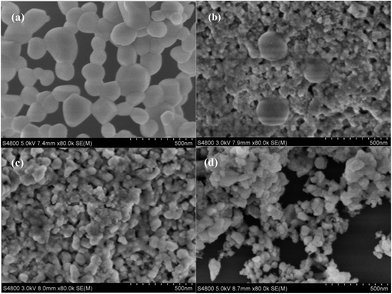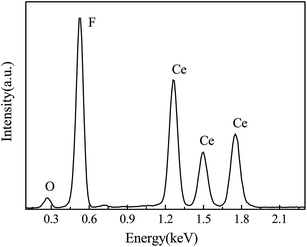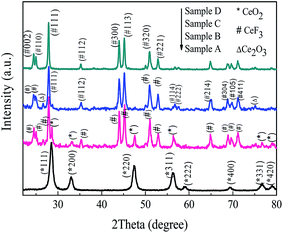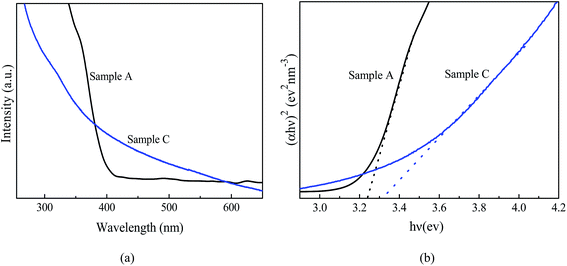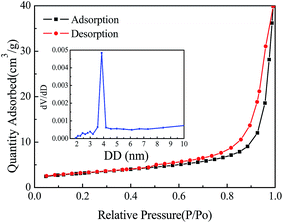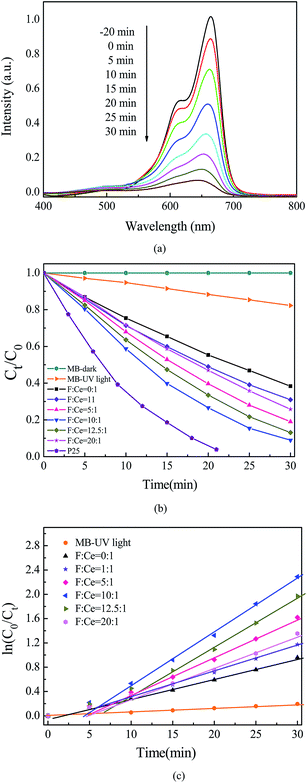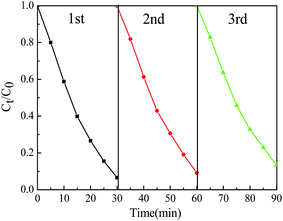A novel photocatalyst CeF3: facile fabrication and photocatalytic performance
Hui Miao,
Gui-Fang Huang*,
Liang Xu ,
Yin-Cai Yang,
Ke Yang and
Wei-Qing Huang*
,
Yin-Cai Yang,
Ke Yang and
Wei-Qing Huang*
Department of Applied Physics, School of Physics and Electronics, Hunan University, Changsha 410082, China. E-mail: gfhuang@hnu.edu.cn; wqhuang@hnu.edu.cn
First published on 23rd October 2015
Abstract
The pursuit of semiconductor photocatalysts with outstanding performance has stimulated increasing efforts to explore novel materials to address problems in environmental remediation and energy utilization. Herein, we first report the synthesis of CeF3 nanoparticles by a facile low-temperature solution combustion method and its performance for photocatalytic degradation of methylene blue (MB) under UV light irradiation. Interestingly, only by adjusting the molar ratios of ammonium fluoride to cerium chloride, pure CeF3 nanoparticles, its mixture with CeO2 and/or Ce2O3, and pure CeO2 nanoparticles can be easily obtained, respectively. The synthesized CeF3 nanoparticles can effectively decompose organic contaminants in aqueous solution and show enhanced photocatalytic activity than CeO2 nanoparticles. Moreover, CeF3 exhibits high stability. The density functional theory (DFT) calculation has been performed to understand the photocatalysis mechanism of CeF3 nanoparticles. This research might provide some new insights for the synthesis of novel photocatalyst with high photocatalytic performance.
1. Introduction
Photocatalytic semiconductors have attracted increasing attention due to their potential applications in renewable energy production and environmental purification by utilizing solar energy.1–4 Among the various photocatalysts, TiO2, the undoubtedly typical and most promising photocatalyst, has been the focus in this field owing to its biological and chemical inertness, cost effectiveness, nontoxicity, and high stability.5 However, its large band gap and the rapid recombination of photogenerated electrons and holes result in the inefficient use of solar energy and low energy efficiency. Therefore, many studies have been performed to modify TiO2 (ref. 6–9) or to seek new efficient photocatalytic materials.2,9,10So far, more than 190 different semiconductor materials have been reported to show activity for the photodegradation of organic pollutants or/and water splitting.11–14 As well-known functional rare-earth metal compounds, cerium-containing nanomaterials have attracted great interest owing to their technological applications and fundamental scientific importance. Among the cerium-containing compounds, CeO2 and CeF3 are two of the typical materials with wide applications in solid-state fuel cells,15 catalysts,9,16–18 polishing materials,4 and so on. It is found that the CeO2 hierarchical nanorods and nanowires synthesized by electrochemical method exhibit substantially higher photocatalytic performance than the commercial CeO2 nanoparticles in the degradation of methyl orange.9 Mao and his coworks find that the N-doped CeO2 nanoparticles possess much higher visible-light sensitivity and enhanced photocatalytic activity compared to pure CeO2.19 Moreover, the activity of CeO2 for the photocatalytic degradation of azodye acid orange 7 (ref. 20) and MB21 is much higher than that of the commercial TiO2 P25, indicating that CeO2 can be used as an effective photocatalyst for environmental remediation.
CeF3 is regarded as an important inorganic material in various fields, such as photocatalytic technology,22 sensors,23 optical components24 and solid lubricants,25 due to its fast response, high ionic conductivity and unique optical property. In comparison with oxygen-based systems, fluorides possess very low vibrational energies, therefore, the quenching of the excited states of the rare earth ions may be minimal and CeF3 is usually considered as luminescent material.26,27 The recent experiment has demonstrated that the CeF3/TiO2 is a more effective photocatalyst for CO2 reduction under visible light than pure TiO2.22 However, the study on the photocatalytic activity of pure CeF3 as a potential photocatalyst has never been reported before. Therefore, it is of great interest to investigate the photocatalytic properties of CeF3 material.
In this work, CeF3 and CeO2 nanoparticles are synthesized by a facile low-temperature solution combustion method. It is interesting that pure CeO2, CeF3 and their mixture can be easily obtained by adjusting the molar ratio of ammonium fluoride to cerium chloride. The photocatalytic activity of the prepared samples is evaluated by degrading MB under UV light irradiation. The results demonstrate that CeF3 shows enhanced photocatalytic activity and can be used as potential photocatalyst.
2. Experimental section
2.1. Preparation of samples
CeF3 and CeO2 nanoparticles are synthesized by low-temperature solution combustion method using citric acid as fuel. All the chemicals are of analytical grade and used as received without further purification. In a typical synthesis process, appropriate ammonium fluoride is dispersed into 20 mL deionized water, followed by addition of 1.86 g cerium chloride heptahydrate, 1.6 g citric acid monohydrate and 2 mL concentrated nitric acid into the every solution under constant stirring at room temperature. The resultant homogeneous solution is transferred into a crucible. Then, the crucible is put into a muffle furnace and heated at 300 °C for about half an hour. Finally, the synthesized samples are washed with distilled water and alcohol, and annealed at 500 °C in air for 2 h. Samples with different molar ratios of ammonium fluoride to cerium chloride (0, 1, 5, 10, 12.5 and 20) are synthesized to investigate the effect of compositions on the structure and photocatalytic performances. The samples with molar ratio of 0, 5, 10 and 20 are marked as samples A, B, C and D, respectively.2.2. Characterizations
The X-ray diffraction patterns (XRD) of samples are measured using Siemens D-5000 diffractometer with Cu Kα irradiation. The morphological details of the prepared samples are probed by an S-4800 field emission scanning electron microscopy (FESEM). The composition of sample B is analyzed by the energy dispersive spectroscopy (EDS) attached to SEM. The Brunauer–Emmett–Teller (BET) specific surface area of the products is analyzed by nitrogen adsorption in a Micromeritics ASAP 2020 nitrogen adsorption apparatus. The optical absorption spectra of the samples are recorded using a UV/vis spectrometer (UV-2450, Shimadzu).2.3. Photocatalytic degradation of MB
The photocatalytic activities of prepared samples are evaluated by the degradation of MB (10 mg L−1, 80 mL) with 30 mg of the photocatalysts under irradiation of 300 W UV lamp. Before irradiation, solutions suspended with photocatalysts are sonicated in the dark for 20 minutes to ensure the adsorption–desorption equilibrium of MB on the surface of photocatalysts. During the irradiation, 5 mL suspension is withdrawn at regular time intervals and centrifuged to remove the photocatalysts. The photodegradation efficiency is monitored by measuring the absorbance of the solution samples at its characteristic absorption wavelength with a UV-vis spectrophotometer at room temperature. The degradation efficiency can be evaluated by the function Ct/C0 × 100%, where C0 is the initial concentration of MB and Ct is the concentration after degradation. For comparison, the self-degradation of MB in dark or under UV light irradiation and the photocatalytic activity of commercial P25 is also explored in the same condition.In order to examine the stability of CeF3, the recycling experiments are carried out under the identical conditions. Each degradation cycle lasts for 30 min, after each photodegradation cycle, the CeF3 photocatalyst is collected by centrifugation, washed with distilled water and alcohol several times, and reused in the following run to repeat the same degradation experiment.
2.4. Computational details
All of the density-functional theory (DFT) calculations have been performed using the frozen-core projector-augmented-wave (PAW) method within the local density approximation (LDA). The quantitative prediction for the chemical and physical properties of CeO2 and CeF3 requires an accurate description of its 4f states. A simple, empirical and weakly-demanding computational approach to obtain appropriate band structure is to add an on-site coulombic repulsion term, leading to the so-called DFT+U approach, which has shown a wide use in studying bulk CeO2 and its composite. For CeO2, the calculated structural parameters, band gap, and the levels in the vicinity to Fermi level obtained from LDA+U, PBE0, and HSE06 are in agreement with each other and coincided with experimental results. Therefore, we choose the DFT/LDA+U method. The extensive tests have been performed to determine the appropriate Hubbard U parameters (Ce 4f and O 2p are 9.0 and 4.5 eV, respectively), which reproduced the correct lattice parameters (5.40 Å) and energy gap (3.2 eV) for cubic CeO2. Considering the similarity of F and O elements, the U value of F 2p is also taken as 4.5 eV. The valence atomic configurations are Ce: 4f1 5d1 6s2, O: 2s2 2p4, and F: 2s2 2p5, respectively. The models are relaxed without any symmetry constraints with a cutoff energy of 500 eV. The convergence of energy and force are set to 10−6 eV and 0.01 eV Å−1, respectively.3. Results and discussion
3.1. Morphology and structure characterization
Generally, the morphology and size of nanoparticles have a great impact on their performance. The morphologies and chemical composition of samples are detected by SEM and EDS, respectively. The typical SEM images of prepared samples A, B, C and D are depicted in Fig. 1. It can be seen from Fig. 1(a) that sample A is composed of irregular particles with size of about 60–120 nm. While there are vast nanoparticles interspersed with some large particles for sample B as shown in Fig. 1(b), suggesting the existence of two phases in sample B. With further increasing the molar ratios of ammonium fluoride to cerium chloride, it can be clearly observed that samples C (Fig. 1(c)) and D (Fig. 1(d)) are composed of nanoparticles which agglomerate to some extent.The EDS spectrum of sample B illustrated in Fig. 2 clearly shows that there are only Ce, O and F elements are detected. The atomic ratio of Ce, O and F is 24.29, 11.12 and 64.58%, respectively, suggesting that rare-earth metal cerium remains in fluoride and oxides.
XRD is employed to investigate the structural information of the prepared samples. The XRD patterns of samples synthesized with different ratio of ammonium fluoride are displayed in Fig. 3. The presence of well defined peaks, as illustrated in Fig. 3, reveals the polycrystalline nature of prepared samples. All the diffraction peaks of the sample synthesized without the addition of ammonium fluoride can be assigned to the diffractions of the (111), (200), (220), (311), (222), (400), (331) and (420) planes of the cubic CeO2 (JCPDS card no. 34-0394). No other peaks can be observed, suggesting the formation of pure CeO2 in sample A. As the molar ratio of ammonium fluoride to cerium chloride increases to 5, the XRD pattern of the sample B includes the patterns of CeO2 (JCPDS card no. 34-0394) and CeF3 (JCPDS card no. 08-0045). In addition, the weak peaks observed at 26.62° and 75.12° in samples B and C can be assigned to the (100) and (203) planes of Ce2O3 (JCPDS card no. 23-1084). This is match with the SEM images and EDS measurement. With further increase the molar ratio of ammonium fluoride to cerium chloride, one can notice that all the diffraction peaks can be attributed to CeF3 in hexagonal phase, indicating that pure CeF3 is obtained.
Fig. 4(a) gives the UV-visible absorption spectra of pure CeO2 (sample A) and pure CeF3 (sample C). It can be seen that the CeO2 nanoparticles exhibit a steep increase in absorption at wavelength of about 400 nm. Whereas CeF3 nanoparticles display a slow increase in absorption in the visible light and ultraviolet ranges, implying that the prepared CeF3 nanoparticles are responsive in the whole wavelength range. The appearance of visible light absorbance of CeF3 in UV-visible absorption spectrum might be attributed to the defects and the distorted lattices.27 Normally, CeF3 is studied as luminescent material. It is reported that the defects existed in CeF3 nanoparticles are responsible for the decrease in the luminescence intensity.27,28 As is well known, the defects existed in semiconductors play a significant role in the light absorption and the corresponding photocatalytic performance.29,30 Thus, the visible light absorbance of CeF3 in UV-visible absorption spectrum might be closely related to its defects. The effects of the defects and the distorted lattices on the visible light absorption will be further discussed in detail in Section 3.3.
It is considered that the energy level and band gap of the semiconductors play a crucial role in determining its photocatalytic activity. Thus the band gap (Eg) of the prepared CeO2 and CeF3 is calculated using the following relationship:
| αhν = A(hν − Eg)2 |
One can infer the material band gap from the intercept of the extrapolated linear region of plots of (αhν)2 versus energy hν on the energy axis, as shown in Fig. 4(b), the roughly estimated indirect band gaps of CeO2 is about 3.23 eV, which are similar to the previous literature.2 The band gap of CeF3 is calculated to be about 3.32 eV, which is slightly larger than that of CeO2.
3.2. Photocatalytic activity for the degradation of MB
As is known, the prerequisite for efficient photodegradation pathway is the pre-adsorption of organic dye molecules on the photocatalyst surface. The BET surface areas of the photocatalysts are determined by the nitrogen adsorption experiments. Fig. 5 shows the nitrogen adsorption–desorption isotherms of sample C. Typically, CeF3 shows isotherms of type IV with a hysteresis loop according to the Brunauer–Deming–Deming–Teller classification. The isotherm exhibits a linear absorption in the low relative pressure range (P/P0 < 0.7), and an obvious hysteresis in the high relative pressure range (0.7 < P/P0 < 1), indicating the presence of mesopores. The plot of the pore-diameter distribution is determined from the desorption branch of the isotherm using the Barrett–Joyner–Halenda (BJH) method. The BJH pore diameter distribution in the inset of Fig. 5 indicates the existence of mesopores with peak at approximately 4 nm. The value of the BET surface area is up to 11.3 m2 g−1 for CeF3, which is similar to that of CeF3 nanoparticles prepared by sonication assisted method.31To elucidate the photocatalytic performances of the prepared samples, photocatalytic degradation of MB is chosen as the probe reaction since MB is usually selected as a typical organic pollutant to test the activity of photocatalysts. The samples are mixed with the MB solution and sonicated in the dark for 20 minutes to reach the adsorption–desorption equilibrium of MB on the surface of photocatalysts. Time dependence of the UV-vis spectra in photodegradation of MB over sample C is illustrated in Fig. 6(a). It is clear that the characteristic absorbance peak decreases after 20 minutes' ultrasonic treatment and further decreases with the increased irradiation time, suggesting that part of MB molecules are adsorbed on the surface when the adsorption–desorption equilibrium reach. The further decrease of the characteristic absorbance peak of MB with irradiation time indicates the photodegradation of MB.
The photocatalytic performance of the prepared samples and commercial P25 is evaluated and the change of the MB concentration during the photo-degradation process is shown in Fig. 6(b). As a comparison, MB degradation with no catalyst is also carried out in dark or under the identical conditions. It is found that the degradation efficiency of MB without photocatalyst is negligible in dark, testifying the stabilization of MB. The degradation efficiency of MB under UV light irradiation increases with the irradiation time, however, the degradation efficiency of MB without a photocatalyst is relatively slow. After 30 min UV light irradiation, only about 18% of MB is photodegraded in the absence of photocatalyst as shown in Fig. 6(b). The slow self-degradation of MB under UV light is similar to the previous report.32 In contrast, the presence of photocatalyst will greatly accelerate the degradation of MB. It can be observed that about 55% of the initial dyes are degraded after 30 min UV light irradiation for CeO2 (sample A). Moreover, the photocatalytic activity is enhanced with the molar ratio increase, and CeF3 (sample C) shows much enhanced photocatalytic activity in the photodegradation of MB, 90% of the initial dyes are degraded after 30 min UV light irradiation. As can be seen from Fig. 6(b), the photocatalytic activity of the prepared CeF3 is close to that of commercial P25. Therefore, CeF3 as a novel photocatalyst shows great application potential in photocatalysis.
The kinetic curves for MB photocatalytic degradation with different photocatalysts are plotted and presented in Fig. 6(c). It can be observed that the relationship between ln(C0/Ct) and irradiation time is almost linear, suggesting the photocatalytic reaction follows the pseudo-fist-order kinetics. According to Langmuir–Hinshelwood model, the apparent reaction rate constant k of MB decomposition under UV light irradiation without photocatalyst is about 0.00687 min−1. While the apparent reaction rate constants k of MB decomposition over samples increase obviously, and the value of k over samples with molar ratios of ammonium fluoride to cerium chloride of 0, 1, 5, 10, 12.5 to 20 are estimated to be about 0.0334 min−1, 0.04398 min−1, 0.06301 min−1, 0.0874 min−1, 0.07812 min−1 and 0.04927 min−1, respectively. From the photodegradation constant k, one can easily compare the photocatalytic performance of different samples. The degradation efficiency of CeF3 (samples C) is more than twice that of CeO2 (samples A).
It is well known that stability of the photocatalyst is crucially important for the practical applications. To evaluate the stability of CeF3, the recycle experiment under identical conditions is carried out. As shown in Fig. 7, the degradation rate of MB is up to 88% over CeF3 photocatalyst under UV light irradiation after the third run, which is similar to that in the first run. The results show that CeF3 photocatalyst exhibit good stability for the UV light degradation of MB.
3.3. Density of states and photocatalysis mechanism
It is known that the fundamental process of semiconductor photocatalysis involves the formation of electron–hole pairs under light irradiation, and the subsequent migration of the photoinduced carriers to the surfaces of semiconductor, which will produce the redox sources of ˙O2− and ˙OH radical species by reacting with the adsorbed O2 and H2O and lead to the destruction of organic pollutants. Thus, the photocatalytic activity of photocatalysts is highly dependent on their band structures and charge transfer dynamics.In order to further clarify the photocatalytic mechanism of CeF3, the electronic structure of CeF3 is explored by employing DFT. Fig. 8 plots the density of state (DOS) and the projected DOS (PDOS) of CeF3 and CeO2, and the band structure of CeF3. The calculated band gaps of CeO2 and CeF3 are 3.20 eV and 3.38 eV, respectively, which are consistent with the experimental value of 3.23 eV and 3.32 eV derived from the UV-visible spectra (Fig. 4). Fig. 8(b) shows that the upper part of valence band of CeO2 is dominated by O 2p states, while the narrow band situated just above the Fermi level is mainly due to 4f states of Ce. Therefore, the pure CeO2 shows an onset of optical absorption about 390 nm, which is attributed to the intrinsic transition from O 2p to Ce 4f states (3.2 eV), in agreement with the UV-vis absorption spectrum (Fig. 4(a)). By contrast, both the upper part of valence band and the bottom of conduction band of CeF3 are composed primarily of Ce 4f states, mixing with a small F 2p states (Fig. 8(a)). The shape of the absorption curve (Fig. 4(a)) of CeF3 indicates that CeF3 is an indirect semiconductor, which can be verified by the band structure (Fig. 8(c)–(e)). Therefore, the smooth upward absorption curve from 600 nm to 250 nm, as shown in Fig. 4(a), of CeF3 cannot be ascribed to the transitions between valence band and conduction band. The optical absorption of CeF3 in the visible light region is closely related to the defect levels appeared in the band gap. It is generally considered that the defects and the degree of disorder in the nanomaterials is relatively high, and thereby a lower crystal field symmetry might be induced and give rise to the change in the absorption spectra.27 In this work, the CeF3 nanoparticles prepared by low-temperature solution combustion are hard to avoid intrinsic defects, such as cerium and oxygen vacancies, especially at the surfaces of nanoparticles. It is reasonable to suppose that the optical absorption of CeF3 in the visible light (Fig. 4(a)) can be attributed to the defects in the samples. In particular, the DOS, just below the Fermi level, of CeF3 is much larger than that of CeO2 (see Fig. 8(a) and (b)). Thus, the values of f–f and p–f matrix elements of the imaginary part of the dielectric function due to direct interband transitions are large, which is one of the key factors for higher photocatalytic activity of CeF3.
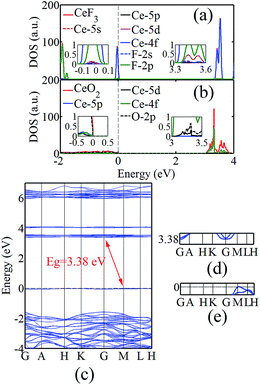 | ||
| Fig. 8 Density of state (DOS) and the projected DOS (PDOS) of (a) CeF3, (b) CeO2. (c) Band structure of CeF3. The zoom view of (d) the bottom of conduction band and (e) the top of valence band. | ||
4. Conclusions
Novel photocatalyst CeF3 is prepared by a facile low-temperature solution combustion method. Pure CeF3 nanoparticles, its mixture with CeO2 and/or Ce2O3, and pure CeO2 nanoparticles can be obtained by adjusting the molar ratios of ammonium fluoride to cerium chloride. The synthesized CeF3 samples are mesopore nanoparticles with specific surface area of 11.3 m2 g−1. It is interesting that the synthesized CeF3 samples show excellent photocatalytic activity and good stability for MB degradation under UV light irradiation. Experiments combined with the DFT calculation reveal that the unique electronic structure of CeF3 may be an important reason for the enhanced photocatalytic performance of CeF3. The present work demonstrates the efficient photocatalytic activity of CeF3, which can be applied as a potential photocatalyst.Acknowledgements
This work is supported by the Changsha Science and Technology Plan Projects, China (Grant No. K1403067-11).References
- Z. G. Yi, J. H. Ye, N. Kikugawa, T. Kako, S. X. Ouyang, H. Stuart-Williams, H. Yang, J. Y. Cao, W. J. Luo, Z. S. Li, Y. Liu and R. L. Withers, Nat. Mater., 2010, 9, 559–564 CrossRef CAS PubMed.
- Z. M. Yang, G. F. Huang, W. Q. Huang, J. M. Wei, X. G. Yan, Y. Y. Liu, C. Jiao, Z. Wan and A. L. Pan, J. Mater. Chem. A, 2014, 2, 1750–1756 CAS.
- J. Di, J. Xia, S. Yin, H. Xu, M. He, H. Li, L. Xu and Y. Jiang, RSC Adv., 2013, 3, 19624–19631 RSC.
- L. Xu, W. Q. Huang, L. L. Wang, Z. A. Tian, W. Y. Hu, Y. M. Ma, X. Wang, A. L. Pan and G. F. Huang, Chem. Mater., 2015, 27, 1612–1621 CrossRef CAS.
- J. G. Yu, Y. R. Su and B. Cheng, Adv. Funct. Mater., 2007, 17, 1984–1990 CrossRef CAS.
- B. C. Qiu, Y. Zhou, Y. F. Ma, X. L. Yang, W. Q. Sheng, M. Y. Xing and J. L. Zhang, Sci. Rep., 2015, 5, 8591 CrossRef CAS PubMed.
- X. B. Wang, Y. Yan, B. Hao and G. Chen, Dalton Trans., 2014, 43, 14054–14060 RSC.
- Z. L. Ma, G. F. Huang, D. S. Xu, M. G. Xia, W. Q. Huang and Y. Tian, Mater. Lett., 2013, 108, 37–40 CrossRef CAS.
- W.-J. Ong, M. M. Gui, S.-P. Chai and A. R. Mohamed, RSC Adv., 2013, 3, 4505–4509 RSC.
- H. Wan, L. Xu, W. Q. Huang, J. H. Zhou, C. N. He, X. F. Li, G. F. Huang, P. Peng and Z. G. Zhou, RSC Adv., 2015, 5, 7944–7952 RSC.
- C. Yu, G. Li, S. Kumar, K. Yang and R. Jin, Adv. Mater., 2014, 26, 892–898 CrossRef CAS PubMed.
- H. Xu, J. Yan, Y. Xu, Y. Song, H. Li, J. Xia, C. Huang and H. Wan, Appl. Catal., B, 2013, 129, 182–193 CrossRef CAS.
- Y. Peng, M. Yan, Q.-G. Chen, C.-M. Fan, H.-Y. Zhou and A.-W. Xu, J. Mater. Chem., 2014, 2, 8517–8524 RSC.
- I. Aslam, C. Cao, M. Tanveer, M. H. Farooq, W. S. Khan, M. Tahir, F. Idrees and S. Khalid, RSC Adv., 2015, 5, 6019–6026 RSC.
- R. Di Monte and J. Kaspar, J. Mater. Chem., 2005, 15, 633–648 RSC.
- L. Xu and J. Wang, Environ. Sci. Technol., 2012, 46, 10145–10153 CAS.
- Y.-Y. Chu, Z.-B. Wang, Z.-Z. Jiang, D.-M. Gu and G.-P. Yin, Adv. Mater., 2011, 23, 3100–3104 CrossRef CAS PubMed.
- W. D. Zhang, D. L. Tang, X. P. Zhou, H. L. Wan and K. R. Tsai, J. Chem. Soc., Chem. Commun., 1994, 771–772 RSC.
- A. L. Mosse, A. V. Gorbunov, A. G. Doroshkevitch and V. N. Ivanova, High Temp. Mater. Processes, 2011, 15, 253–258 CrossRef.
- P. Ji, J. Zhang, F. Chen and M. Anpo, J. Phys. Chem. C, 2008, 112, 17809–17813 CAS.
- F. Chen, Y. Cao and D. Jia, Appl. Surf. Sci., 2011, 257, 9226–9231 CrossRef CAS.
- C. N. Tang, W. Q. Hou, E. Z. Liu, X. Y. Hu and J. Fan, J. Lumin., 2014, 154, 305–309 CrossRef CAS.
- Y. Chen, T. M. Liu, C. L. Chen, W. W. Guo, R. Sun, S. H. Lv, M. Saito, X. H. Peng, S. Tsukimoto and Z. C. Wang, Phys. E, 2013, 48, 181–186 CrossRef CAS.
- Y. Y. Li and S. Q. Xu, J. Alloys Compd., 2014, 601, 195–200 CrossRef CAS.
- D. P. Feng, W. M. Liu and Q. J. Xue, Mater. Sci. Eng., A, 2002, 326, 195–201 CrossRef.
- M. Kovács, Z. Valicsek, J. Tóth, L. Hajba, É. Makó and P. Halmos, Colloids Surf., A, 2009, 352, 56–62 CrossRef.
- L. Zhu, Q. Li, X. D. Liu, J. Y. Li, Y. F. Zhang, J. Meng and X. Q. Cao, J. Phys. Chem. C, 2007, 111, 5898–5903 CAS.
- Y. Liu, Y. Zhao, L. Yu and Z. Wu, J. Alloys Compd., 2009, 485, L1–L4 CrossRef CAS.
- X. Y. Pan, M. Q. Yang and X. Z. Fu, et al., Nanoscale, 2013, 5(9), 3601–3614 RSC.
- M. M. Khan, S. A. Ansari and D. Pradhan, et al., J. Mater. Chem. A, 2014, 2(3), 637–644 CAS.
- D. A. Kumar, S. Selvasekarapandian, H. Nithya and Y. Masuda, Solid State Sci., 2012, 14, 626–634 CrossRef.
- R. F. Zuo, G. X. Du, W. W. Zhang, L. H. Liu, Y. M. Liu, L. F. Mei and Z. H. Li, Adv. Mater. Sci. Eng., 2014, 170148 Search PubMed.
| This journal is © The Royal Society of Chemistry 2015 |

